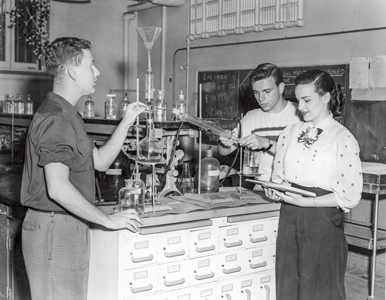
1916: The first-ever degree awarded by AU was a PhD in chemistry. Elbert Clyde Lathron, a biochemist in the Bureau of Plant Industry at the US Department of Agriculture (USDA), wrote his dissertation on the “organic nitrogen compounds of soils and fertilizers.” That spring, AU also awarded a master’s in agriculture and a doctorate in agriculture economics to two other USDA employees. AU’s partnership with the agency, which opened its labs to students, ended in the 1920s.
1925: AU’s College of Arts and Sciences (CAS) welcomed its inaugural class of 75 undergrads—more than half of whom were women. Among the 17 majors: biology, chemistry, and physics.
1941: In September, faculty voted to require one year of laboratory science for all CAS students, according to the Eagle. Previously, students could choose between “modern foreign language, social science, science and mathematics, and humanities.”
1955: CAS debuted a master’s in chemistry. The first graduates collected their diplomas in June 1957.
1967: The $1.1 million Beeghly Chemistry Building, nestled on the west side of campus, opened. The 33,000-square-foot building included 11 research labs, 10 faculty offices, eight teaching labs, and a lecture hall. Today, the chemistry department—which offers bachelor’s and master’s degrees and a graduate certificate in clinical biochemistry—still works out of Beeghly.
2008: Environmental science became a standalone unit. According to chair Kiho Kim, the move was “an acknowledgement of the importance of the environment in all aspects of our living.” The program now offers two bachelor’s degrees, a master’s, and a certificate in environmental assessment.
2012: The Center for Behavior Neuroscience debuted, establishing AU as an epicenter for research on depression, addiction, and cognitive dementia. “Our center integrates knowledge in psychology, biology, chemistry, and physics with neuroanatomy and physiology to advance our understanding of the cognitive, emotional, sensory, and regulatory functions that underlie human behavior,” said founding director Terry Davidson. AU offers a PhD in behavior, cognition, and neuroscience and a bachelor’s in neuroscience.
2018: In September, Board of Trustees member Gary Abramson, SPA/BA ’68, and his wife, Pennie, made a $5 million gift to kick off construction of the new Hall of Science. Over the last five years, CAS faculty have grown their research funding by 116 percent, securing 48 awards from the National Institutes of Health and the National Science Foundation. Science is also AU’s fastest-growing area of undergraduate study. The state-of-the-art facility will enable AU’s scientists and students to tackle issues like climate change, cancer, and obesity. “In an ever-changing world, science is essential to how society approaches its greatest opportunities and challenges,” said the Abramsons. “AU students and faculty deserve a space that matches their ambition and affords them every opportunity to advance scientific discovery.” In honor of their generosity, the Hall of Science auditorium will be named Gary and Pennie Abramson Discovery Hall.